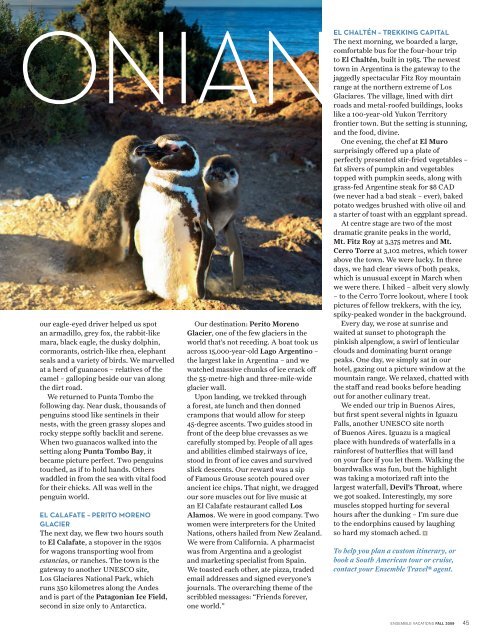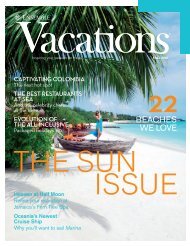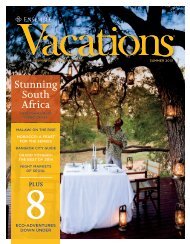Picture - Ensemble Vacations Magazine
Picture - Ensemble Vacations Magazine
Picture - Ensemble Vacations Magazine
- No tags were found...
You also want an ePaper? Increase the reach of your titles
YUMPU automatically turns print PDFs into web optimized ePapers that Google loves.
ONIAN<br />
our eagle-eyed driver helped us spot<br />
an armadillo, grey fox, the rabbit-like<br />
mara, black eagle, the dusky dolphin,<br />
cormorants, ostrich-like rhea, elephant<br />
seals and a variety of birds. We marvelled<br />
at a herd of guanacos – relatives of the<br />
camel – galloping beside our van along<br />
the dirt road.<br />
We returned to Punta Tombo the<br />
following day. Near dusk, thousands of<br />
penguins stood like sentinels in their<br />
nests, with the green grassy slopes and<br />
rocky steppe softly backlit and serene.<br />
When two guanacos walked into the<br />
setting along Punta Tombo Bay, it<br />
became picture perfect. Two penguins<br />
touched, as if to hold hands. Others<br />
waddled in from the sea with vital food<br />
for their chicks. All was well in the<br />
penguin world.<br />
EL CALAFATE – PERITO MORENO<br />
GLACIER<br />
The next day, we flew two hours south<br />
to El Calafate, a stopover in the 1930s<br />
for wagons transporting wool from<br />
estancias, or ranches. The town is the<br />
gateway to another UNESCO site,<br />
Los Glaciares National Park, which<br />
runs 350 kilometres along the Andes<br />
and is part of the Patagonian Ice Field,<br />
second in size only to Antarctica.<br />
Our destination: Perito Moreno<br />
Glacier, one of the few glaciers in the<br />
world that’s not receding. A boat took us<br />
across 15,000-year-old Lago Argentino –<br />
the largest lake in Argentina – and we<br />
watched massive chunks of ice crack off<br />
the 55-metre-high and three-mile-wide<br />
glacier wall.<br />
Upon landing, we trekked through<br />
a forest, ate lunch and then donned<br />
crampons that would allow for steep<br />
45-degree ascents. Two guides stood in<br />
front of the deep blue crevasses as we<br />
carefully stomped by. People of all ages<br />
and abilities climbed stairways of ice,<br />
stood in front of ice caves and survived<br />
slick descents. Our reward was a sip<br />
of Famous Grouse scotch poured over<br />
ancient ice chips. That night, we dragged<br />
our sore muscles out for live music at<br />
an El Calafate restaurant called Los<br />
Alamos. We were in good company. Two<br />
women were interpreters for the United<br />
Nations, others hailed from New Zealand.<br />
We were from California. A pharmacist<br />
was from Argentina and a geologist<br />
and marketing specialist from Spain.<br />
We toasted each other, ate pizza, traded<br />
email addresses and signed everyone’s<br />
journals. The overarching theme of the<br />
scribbled messages: “Friends forever,<br />
one world.”<br />
EL CHALTÉN – TREKKING CAPITAL<br />
The next morning, we boarded a large,<br />
comfortable bus for the four-hour trip<br />
to El Chaltén, built in 1985. The newest<br />
town in Argentina is the gateway to the<br />
jaggedly spectacular Fitz Roy mountain<br />
range at the northern extreme of Los<br />
Glaciares. The village, lined with dirt<br />
roads and metal-roofed buildings, looks<br />
like a 100-year-old Yukon Territory<br />
frontier town. But the setting is stunning,<br />
and the food, divine.<br />
One evening, the chef at El Muro<br />
surprisingly offered up a plate of<br />
perfectly presented stir-fried vegetables –<br />
fat slivers of pumpkin and vegetables<br />
topped with pumpkin seeds, along with<br />
grass-fed Argentine steak for $8 CAD<br />
(we never had a bad steak – ever), baked<br />
potato wedges brushed with olive oil and<br />
a starter of toast with an eggplant spread.<br />
At centre stage are two of the most<br />
dramatic granite peaks in the world,<br />
Mt. Fitz Roy at 3,375 metres and Mt.<br />
Cerro Torre at 3,102 metres, which tower<br />
above the town. We were lucky. In three<br />
days, we had clear views of both peaks,<br />
which is unusual except in March when<br />
we were there. I hiked – albeit very slowly<br />
– to the Cerro Torre lookout, where I took<br />
pictures of fellow trekkers, with the icy,<br />
spiky-peaked wonder in the background.<br />
Every day, we rose at sunrise and<br />
waited at sunset to photograph the<br />
pinkish alpenglow, a swirl of lenticular<br />
clouds and dominating burnt orange<br />
peaks. One day, we simply sat in our<br />
hotel, gazing out a picture window at the<br />
mountain range. We relaxed, chatted with<br />
the staff and read books before heading<br />
out for another culinary treat.<br />
We ended our trip in Buenos Aires,<br />
but first spent several nights in Iguazu<br />
Falls, another UNESCO site north<br />
of Buenos Aires. Iguazu is a magical<br />
place with hundreds of waterfalls in a<br />
rainforest of butterflies that will land<br />
on your face if you let them. Walking the<br />
boardwalks was fun, but the highlight<br />
was taking a motorized raft into the<br />
largest waterfall, Devil’s Throat, where<br />
we got soaked. Interestingly, my sore<br />
muscles stopped hurting for several<br />
hours after the dunking – I’m sure due<br />
to the endorphins caused by laughing<br />
so hard my stomach ached. nV<br />
To help you plan a custom itinerary, or<br />
book a South American tour or cruise,<br />
contact your <strong>Ensemble</strong> Travel® agent.<br />
ENSEMBLE VACATIONS FALL 2009<br />
45












